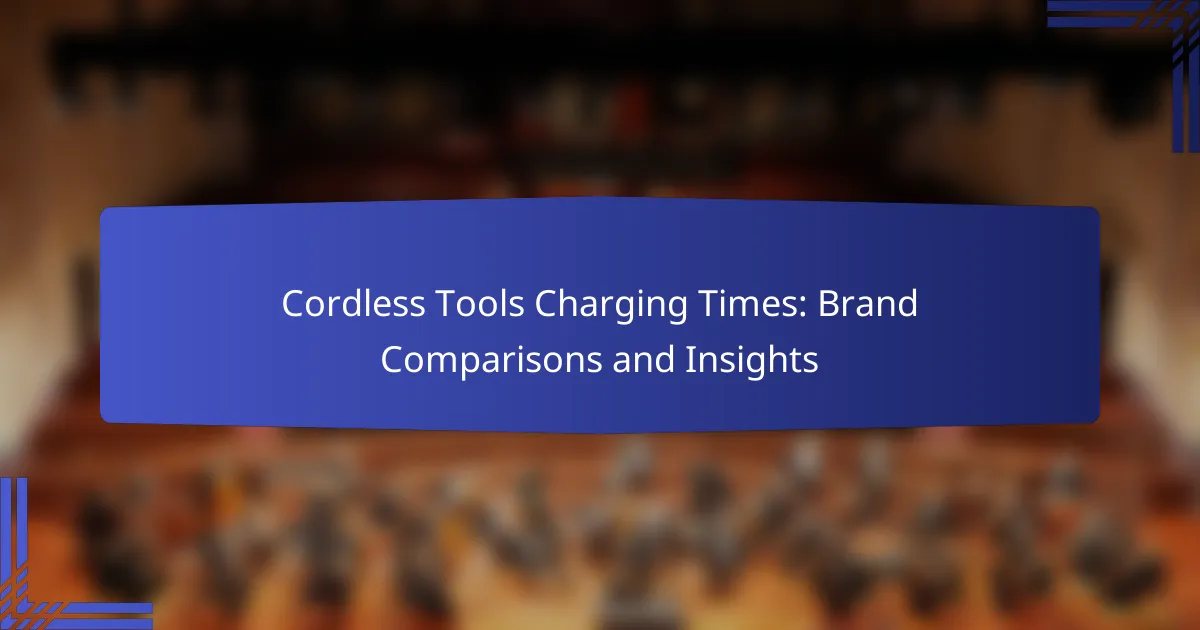Charging times for cordless tools can differ greatly among brands, influenced by factors such as battery capacity and charger efficiency. Typically, users can expect charging durations ranging from about 30 minutes to several hours. By understanding these variations, users can choose tools that reduce downtime and boost productivity.

What are the charging times for popular cordless tool brands?
Charging times for cordless tool brands vary significantly based on the battery capacity and charger type. Generally, most brands offer charging times ranging from around 30 minutes to several hours, depending on the specific tool and battery used.
DeWalt charging times
DeWalt tools typically feature charging times that can range from 30 minutes to 1.5 hours. Their Fast Charger can recharge a 20V MAX battery in about 30 minutes, while standard chargers may take up to 1.5 hours for larger capacity batteries.
When using DeWalt tools, consider the battery size and the type of charger you have, as these factors will significantly influence the total charging time.
Makita charging times
Makita offers a variety of charging options, with charging times generally between 30 minutes and 1 hour. Their rapid chargers can fully charge a 18V LXT battery in approximately 30 minutes, while standard chargers may take longer for larger batteries.
For optimal performance, it’s advisable to use Makita’s recommended chargers to ensure efficient charging and battery longevity.
Milwaukee charging times
Milwaukee charging times vary, with most batteries taking between 30 minutes to 2 hours to fully charge. Their M18 REDLITHIUM batteries can be charged in about 30 minutes with a rapid charger, while standard chargers may require more time for larger batteries.
To maximize battery life, avoid letting the battery discharge completely before recharging whenever possible.
Bosch charging times
Bosch cordless tools usually have charging times that range from 30 minutes to about 1.5 hours. Their 18V batteries can be charged in around 30 minutes with a fast charger, while standard chargers may take longer depending on the battery capacity.
Using Bosch’s specific chargers is recommended to ensure compatibility and efficient charging.
Ryobi charging times
Ryobi charging times can vary widely, typically ranging from 30 minutes to 3 hours. Their 18V ONE+ system allows for charging in about 30 minutes with a fast charger, but larger batteries may take longer with standard chargers.
For best results, consider the battery size and choose the appropriate charger to reduce downtime and maintain battery health.
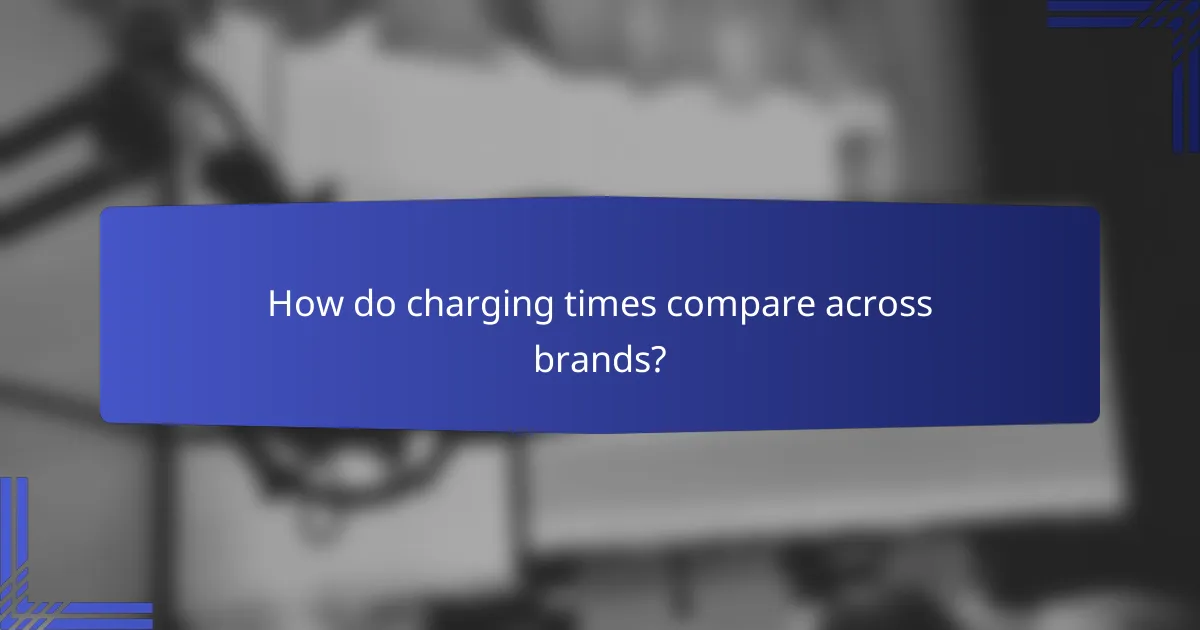
How do charging times compare across brands?
Charging times for cordless tools vary significantly across brands, influenced by battery technology and charger efficiency. Understanding these differences can help users select tools that minimize downtime and enhance productivity.
DeWalt vs. Makita
DeWalt and Makita are both known for their reliable cordless tools, but their charging times can differ. DeWalt’s fast charger can fully charge a 20V MAX battery in about 30 to 60 minutes, while Makita’s rapid charger typically takes around 45 to 75 minutes for a similar battery. Users should consider the specific model and battery capacity when comparing these brands.
For those who prioritize speed, DeWalt’s charging technology may offer an edge, especially for professionals needing quick turnaround times on job sites. However, Makita’s batteries often provide longer run times, which can offset the slightly longer charging period.
Milwaukee vs. Bosch
Milwaukee and Bosch offer competitive charging times, though Milwaukee tends to lead in rapid charging capabilities. Milwaukee’s REDLITHIUM batteries can charge in approximately 30 to 60 minutes, while Bosch’s 18V batteries generally require about 45 to 90 minutes to reach full capacity. This difference can impact workflow efficiency, particularly in demanding environments.
When choosing between these brands, consider the type of work being done. Milwaukee’s faster charging may be beneficial for high-intensity tasks, while Bosch’s robust battery life can be advantageous for extended use without frequent recharges.
Ryobi vs. DeWalt
Ryobi’s charging times are generally longer compared to DeWalt, with Ryobi’s 18V batteries taking around 60 to 90 minutes to charge fully. In contrast, DeWalt’s 20V MAX batteries can recharge in about 30 to 60 minutes. This difference can be crucial for users who need to maximize tool availability.
While Ryobi offers a more budget-friendly option, the trade-off may be longer wait times for charging. Users should assess their specific needs and whether the cost savings outweigh the potential downtime associated with longer charging periods.
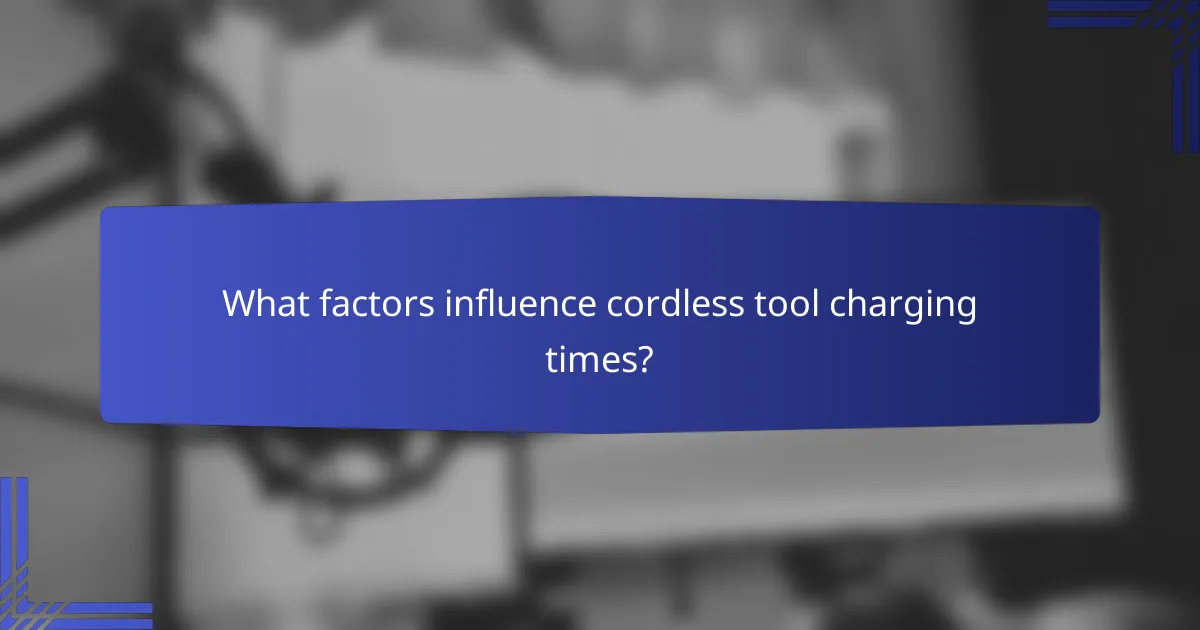
What factors influence cordless tool charging times?
Several factors significantly impact the charging times of cordless tools, including battery capacity, charger type, and temperature conditions. Understanding these elements can help users optimize their charging practices and improve tool efficiency.
Battery capacity
Battery capacity, measured in amp-hours (Ah), directly affects how long it takes to charge a cordless tool. Higher capacity batteries typically take longer to charge, as they store more energy. For example, a 4Ah battery may take twice as long to charge as a 2Ah battery, assuming the same charger is used.
When selecting a battery, consider your usage needs. If you frequently use tools for extended periods, investing in a higher capacity battery may be beneficial, despite the longer charging time.
Charger type
The type of charger used can greatly influence charging times. Standard chargers may take several hours to fully charge a battery, while fast chargers can reduce this time to under an hour. However, using a fast charger on a battery not designed for it can lead to overheating and reduced battery lifespan.
For optimal performance, always use the charger recommended by the manufacturer. This ensures compatibility and helps maintain battery health over time.
Temperature effects
Temperature plays a crucial role in charging efficiency. Most batteries charge best at room temperature, typically between 20°C and 25°C (68°F and 77°F). Extreme cold can slow down the chemical reactions within the battery, leading to longer charging times.
To avoid issues, store batteries in a temperature-controlled environment and allow them to reach room temperature before charging. This practice can help ensure faster and safer charging.
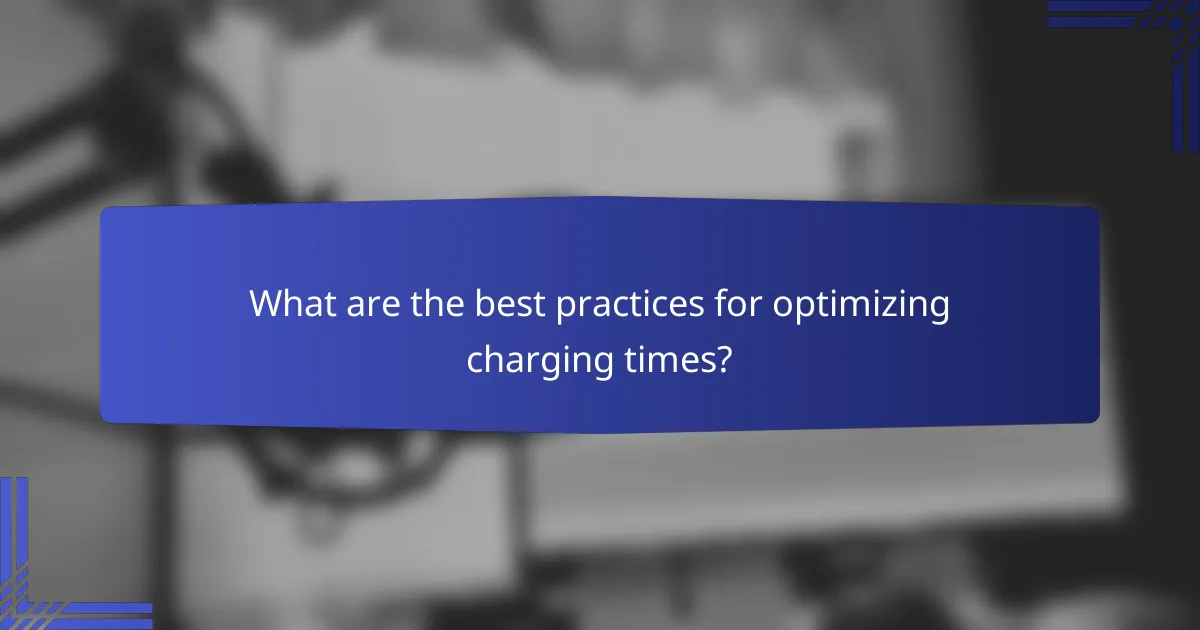
What are the best practices for optimizing charging times?
To optimize charging times for cordless tools, use compatible chargers, maintain battery health, and charge in optimal conditions. These practices ensure efficient charging and prolong the lifespan of your batteries.
Using compatible chargers
Using chargers specifically designed for your cordless tool brand is crucial for optimizing charging times. Compatible chargers provide the correct voltage and current, reducing the risk of overheating and damage. Always check the manufacturer’s recommendations to ensure you are using the right charger.
For example, a DeWalt charger may charge a battery in about 60 minutes, while a generic charger could take significantly longer and may not fully charge the battery. Investing in the right charger can save time and enhance performance.
Maintaining battery health
Maintaining battery health is essential for efficient charging and longevity. Regularly check for signs of wear, such as swelling or corrosion, and replace batteries that show these signs. Keeping batteries clean and free from debris can also improve their performance.
Additionally, avoid letting batteries fully discharge before recharging. Instead, aim to recharge them when they reach around 20-30% capacity. This practice can help maintain battery capacity over time.
Charging in optimal conditions
Charging your cordless tool batteries in optimal conditions can significantly affect charging times. Ideally, charge batteries in a cool, dry environment, as extreme temperatures can slow down the charging process and damage the battery. Aim for temperatures between 10°C and 30°C (50°F to 86°F) for best results.
Moreover, avoid charging batteries in direct sunlight or near heat sources. If possible, remove the battery from the tool before charging to ensure even heat distribution and faster charging times.
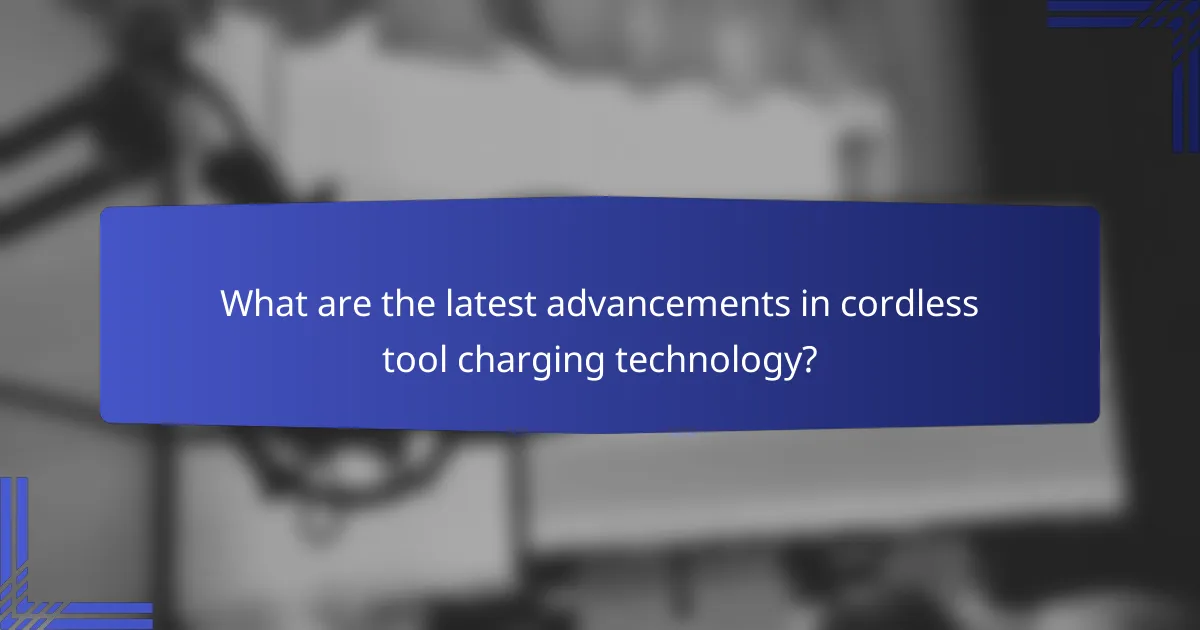
What are the latest advancements in cordless tool charging technology?
Recent advancements in cordless tool charging technology focus on faster charging times and smarter charging systems. These innovations enhance user convenience and efficiency, allowing tools to be ready for use in shorter periods.
Fast charging innovations
Fast charging innovations have significantly reduced the time it takes to recharge cordless tools. Many brands now offer chargers that can fully charge batteries in under an hour, with some high-performance options achieving this in as little as 15-30 minutes. This is particularly beneficial for professionals who rely on their tools for continuous work.
Technologies such as lithium-ion batteries and advanced charging circuits contribute to these rapid charging capabilities. Users should consider the compatibility of their tools with fast chargers, as not all batteries support this feature, which can impact overall efficiency.
Smart charging features
Smart charging features incorporate technology that optimizes the charging process based on battery health and usage patterns. These systems can adjust the charging speed and monitor battery temperature, preventing overheating and extending battery life. Some chargers even offer connectivity options, allowing users to track charging status via mobile apps.
When selecting cordless tools, look for models with smart charging capabilities to ensure longevity and reliability. Avoid using non-compatible chargers, as this can lead to reduced performance and potential damage to the battery.

How do charging times affect tool performance?
Charging times significantly influence the overall performance of cordless tools. Shorter charging times allow for more efficient use of the tool, minimizing downtime and maximizing productivity on the job site.
Impact on work efficiency
Work efficiency is directly tied to how quickly a cordless tool can be charged and ready for use. If a tool takes too long to recharge, it can lead to delays in project timelines and increased frustration for users.
For instance, a tool that charges in about 30 minutes can provide a quick turnaround for tasks, while one that requires several hours may hinder workflow. It’s essential to consider the balance between battery capacity and charging speed when selecting tools for specific jobs.
To optimize work efficiency, choose tools with fast-charging capabilities and ensure you have multiple batteries available. This way, while one battery is in use, another can be charging, reducing interruptions during work. Common pitfalls include relying on a single battery and underestimating the time needed for charging, which can disrupt project flow.
